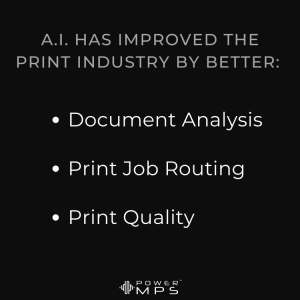The past couple of decades have pushed the limits of technological advancements. From the home computer launch to the internet’s adoption, the timelines for jumps in data use, software, and hardware capabilities have continued to shrink. Printer manufacturing and office printing services are no different. Just as has been seen in medicine, finance, agriculture, and many other industries, office printing is continually working to develop new, innovative ways to improve printing capabilities.
Through this continued technological advancement, office printing is now more efficient than ever. As a result, high-quality printed documents are more easily attainable, printed faster, and more vibrant than ever before. In addition, printing equipment is more energy-efficient, more interactive, and longer-lasting. But, just as the office space and business models are rapidly changing, office printing technology continues to evolve to better suit new corporate needs. Here are a few ways the office print industry is churning out technology designed to impress.
Artificial Intelligence Enters the Printing World

Human resources are irreplaceable. And, no matter how much technology advances, the employee workforce is still crucial in the office. But that doesn’t mean there is no space for new, improved artificial intelligence (AI) to create a more efficient workspace. For example, AI for printing can help improve a variety of tasks, including:
- Document Analysis. In the spirit of “going green” in the office, minimizing waste should be a priority when printing documents. The printing industry has designed AI capable of analyzing documents before they are printed to determine the type of formatting required to minimize toner, ink, and paper use. The result is a reduction in supply usage that generates nice long-term cost savings.
- Print Job Routing. Larger offices and businesses in legal, medicine, and finance that are heavy printers often run into the issue of time lost waiting for items to run through a print queue. Creating a more efficient system in these situations can lead to smoother workflows and better use of employee time. This is why some printer manufacturers have focused on developing AI to appropriately route print jobs for higher efficiency. For some companies, this could mean print jobs are automatically sent to the nearest idle machine. For others, the system could monitor print queue sizes and allocate jobs to devices based on anticipated print timelines.
- Improving Print Quality. Especially when investing in newer printer equipment, businesses expect the print quality to be higher than what they would receive from older printers. Advances in printer AI help monitor various components within the printer to adjust speeds, heat, and other factors to ensure clearer copies and more vibrant images while generating less waste in ink, toner, and paper.
Better Ink and Toner
When thinking of technological advancements in the print industry, most people might imagine smaller, faster printers. However, rarely does anyone consider the consumables used to create the print. But printer manufacturers constantly look for ways to improve ink and toner for newer machines.
There are various ways manufacturers are looking to improve the ink and toner used in today’s printers. One of those is to meet the demands of environmental conservation. Today’s ink and toner markets are looking to eliminate toxins, lower the use of chemicals, and reduce landfill waste. This is why many ink cartridges are now made with remanufactured materials, and there are a variety of vegetable-based, soy-based, and even algae-based inks.
Additionally, manufacturers are developing water-based inks that dry faster to eliminate the risk of fuzzy images and text. These inks produce clearer, crisper prints and copies perfect for sales presentations and documents heavy in text.
Advanced Inkjet Printing Speeds
When it comes to circulating information in the office, timeliness is everything. The faster a document can print, the quicker it can be sent to all parties of interest and get on with other business activities. In this respect, laser printers have proven to be the consistent winner.
Today manufacturers are working hard on new ways to advance the speeds of inkjet printers. Brother has released inkjet models that print up to 22 pages per minute. HP has options that can produce prints at up to 70 pages per minute.
Integration With Other Services and Technologies
Integration is an essential aspect of any technological advancement. Without the integration of services, printers will be stuck in the pre-digital era. So, it is no surprise that printing manufacturers and service providers are working hard to create connections that make office printing more efficient and effective for today’s business environments.
With so many hybrid office setups and the slow re-introduction of business meetings and events, mobile is considered one of the best integrations for office printers. So, the print industry is working hard to develop and implement technologies that make it easier for office printers to accept print requests and share scanned files with mobile devices.
Another up-and-coming integration is voice-activated printing. Rather than searching for a file and manually choosing print settings, voice-activated printing could allow users to tell the system the document, color, size, and the number of copies – all with a voice command.
In today’s fast-paced technological development environment, keeping pace with business needs is key to staying efficient and relevant. With mobile integration, voice activation, artificial intelligence, and faster, clearer printing, the office printing industry is clearly up to the challenge. And there is no telling what new technologies printer manufacturers and printing services will develop next.


Comments (0)